
Balcombe tunnel is a railway tunnel on the Brighton Main Line through the Sussex Weald between Three Bridges and Balcombe. It is 1,034 metres (1,131 yards) long. [1] The track is electrified with a 750 V DC third-rail.

Balcombe tunnel is a railway tunnel on the Brighton Main Line through the Sussex Weald between Three Bridges and Balcombe. It is 1,034 metres (1,131 yards) long. [1] The track is electrified with a 750 V DC third-rail.
This article needs to be updated.(June 2019) |
The tunnel was constructed by the London and Brighton Railway between 1838 and 1841, through Grinstead Clay, with five ventilation shafts. [1] The engineer for the line was John Urpeth Rastrick; the contractor responsible for the brick-lined tunnel is not known. [2] Ingress of water from the ground above was experienced during the construction of the tunnel, and this has remained a problem throughout its history. [3] Rastrick described the tunnelling as very treacherous, requiring great caution on the part of the miners working it, as "it swells and effloresces as soon as exposed to the air." [4] Between 1907 and 1909 the tunnel was partially relined with engineering brick. [1]
Galvanised iron sheets were fitted to prevent the water falling on passengers in open carriages, but the blast from the steam locomotives and air pressure created by the passage of trains could result in the metal sheets being torn from the structure, creating a serious hazard. Thereafter drivers were warned about the hazard presented by hanging icicles.
The "railway murderer" Percy Lefroy Mapleton left the body of his victim Isaac Gold, whom he had robbed, in Balcombe tunnel in 1881.
In July 1903 plans were finalised for the boring of a second Balcombe tunnel as part of the scheme to quadruple the Brighton Main Line throughout, but these were never implemented. [5]
In 1998/9 catchment trays were fitted under the tunnel's ventilation shafts to divert seeping ground water from the shafts into the track drainage system, with a sixth added in 2006/7. The trays consisted of steel decking, gutters and flashings which were installed under limited track possessions. [1] The tray supports had failed by 2013, requiring the installation of additional support brackets, and the Office of Rail Regulation enforced improvements in tunnel examination procedures. [1]
In 2018 and 2019, works were carried out to improve the tunnel, carrying out significant works on the drainage system, as well as replacing switches and crossings at Balcombe tunnel junction, as a part of wider works along the Brighton Mainline. [6]
North portal - see http://www.safeguardeurope.com/case_studies/tunnel_waterproofing_balcombe.php
Aerial view - see http://wikimapia.org/7962596/Balcombe-Tunnel
Junction works timelapse video - see https://www.youtube.com/watch?v=hVsKl3fiquQ

Box Tunnel passes through Box Hill on the Great Western Main Line (GWML) between Bath and Chippenham. The 1.83-mile (2.95 km) tunnel was the world's longest railway tunnel when it was completed in 1841.

The Severn Tunnel is a railway tunnel in the United Kingdom, linking South Gloucestershire in the west of England to Monmouthshire in south Wales under the estuary of the River Severn. It was constructed by the Great Western Railway (GWR) between 1873 and 1886 for the purpose of dramatically shortening the journey times of their trains, passenger and goods alike, between South Wales and Western England. It has often been regarded as the crowning achievement of GWR's chief engineer Sir John Hawkshaw.

The Kilsby Tunnel is a railway tunnel on the West Coast Main Line in England, near the village of Kilsby in Northamptonshire, roughly 5 miles (8 km) southeast of Rugby. It is 2,423 yards (2,216 m) long.

Brighton railway station is the southern terminus of the Brighton Main Line, the western terminus of the East Coastway Line and the eastern terminus of the West Coastway Line in England, and the principal station serving the city of Brighton, East Sussex. It is 50 miles 49 chains from London Bridge via Redhill.
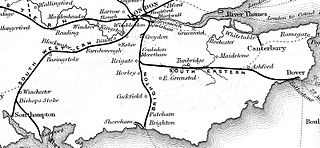
The London and Brighton Railway (L&BR) was a railway company in England which was incorporated in 1837 and survived until 1846. Its railway ran from a junction with the London and Croydon Railway (L&CR) at Norwood – which gives it access from London Bridge, just south of the River Thames in central London. It ran from Norwood to the South Coast at Brighton, together with a branch to Shoreham-by-Sea.

The East Coastway line is a railway line along the south coast of Sussex to the east of Brighton, England. Trains to the west of Brighton operate on the West Coastway line. Together with the West Coastway and the Marshlink line to the east, the line forms part of a continuous route from Havant to Ashford. The Brighton Main Line route to Eastbourne and Hastings, via Plumpton and Cooksbridge, shares the East Coastway line east of Lewes station.
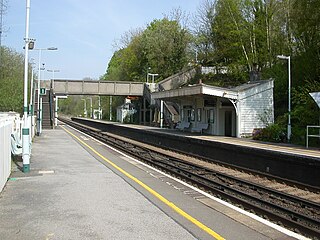
Balcombe railway station is on the Brighton Main Line in England, serving the village of Balcombe, West Sussex. It is 33 miles 64 chains (54.4 km) down the line from London Bridge via Redhill and is situated between Three Bridges and Haywards Heath. It is managed by Southern, but trains calling at the station are operated by Thameslink.

Haywards Heath railway station is on the Brighton Main Line in England, serving the town of Haywards Heath, West Sussex. It is 37 miles 59 chains down the line from London Bridge via Redhill and is situated between Balcombe and Wivelsfield. It is managed by Southern.

Preston Park railway station is on the Brighton Main Line in England, serving Preston Village and the northern suburban areas of the city of Brighton and Hove, East Sussex. It is 49 miles 21 chains (79.3 km) from London Bridge via Redhill, between Hassocks and Brighton.

Hassocks railway station is on the Brighton Main Line in England, serving the village of Hassocks, West Sussex. It is 43 miles 42 chains (70.0 km) down the line from London Bridge via Redhill and is situated between Burgess Hill and Preston Park. It is managed by Southern.

Lancing railway station is in Lancing in the county of West Sussex, England. It is 8 miles 19 chains (13.3 km) down the line from Brighton. The station is operated by Southern.

Balcombe is a village and civil parish in the Mid Sussex District of West Sussex, England. It lies 31 miles (50 km) south of London, 16 miles (26 km) north of Brighton, and 32 miles (51 km) east-northeast of the county town of Chichester. Nearby towns include Crawley to the northwest and Haywards Heath to the south-southeast.

Portslade railway station is a railway station located in Portslade-by-Sea in the city of Brighton and Hove, East Sussex, England, but located on the western fringes of the village of Aldrington. It is 2 miles 73 chains (4.7 km) down the line from Brighton.

Aldrington railway station, sometimes known by its former names of Aldrington Halt and Dyke Junction, is a railway station that serves the area of Aldrington in Brighton and Hove, in East Sussex, England. The station is 1 mile 74 chains (3.1 km) from Brighton on the West Coastway Line.

The Ouse Valley Viaduct carries the London-Brighton Railway Line over the River Ouse in Sussex. It is located to the north of Haywards Heath and the south of Balcombe. Known for its ornate design, the structure has been described as "probably the most elegant viaduct in Britain."
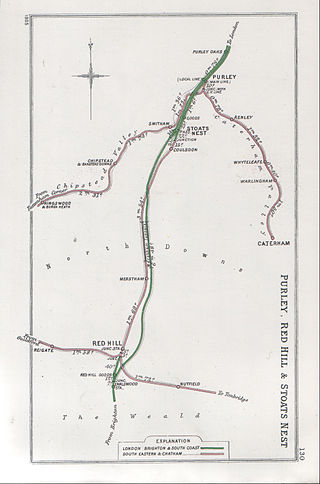
The Merstham and Quarry tunnels are two neighbouring railway tunnels on the Brighton Main Line between Merstham and Coulsdon in Surrey, Great Britain.
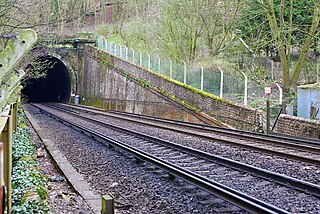
Patcham Tunnel is a railway tunnel on the Brighton Main Line through the South Downs between Preston Park and Hassocks in East Sussex, England. It is 446 metres long.
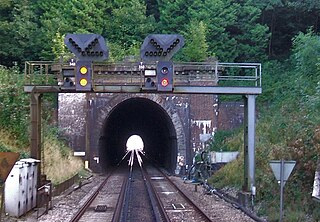
Haywards Heath Tunnel is a railway tunnel on the Brighton Main Line between Haywards Heath and Wivelsfield. It is 264 yards long and is one of the shortest tunnels on the line.

The Brighton, Lewes and Hastings Railway was an early railway in southern England that built the East Coastway line running between the three East Sussex towns mentioned in its name. The company existed from February 1844 but only operated trains for a few weeks during June and July 1846 before it was amalgamated with other companies to form the London Brighton and South Coast Railway (LB&SCR) on 27 July 1846.
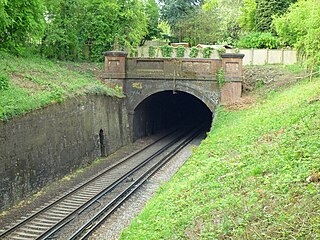
Redhill Tunnel is a railway tunnel passing under the eastern area of Redhill in Surrey, Great Britain. It is on the 'Quarry Line' section of the Brighton Main Line and was constructed in 1899. The tunnel is 502 yards (459 m) in length but abuts on to a covered way under the Redhill to Tonbridge Line and Redhill sidings, giving a total length of 649 yards (593 m). There is another Redhill Tunnel on the Midland Main Line south of Trent Junction.